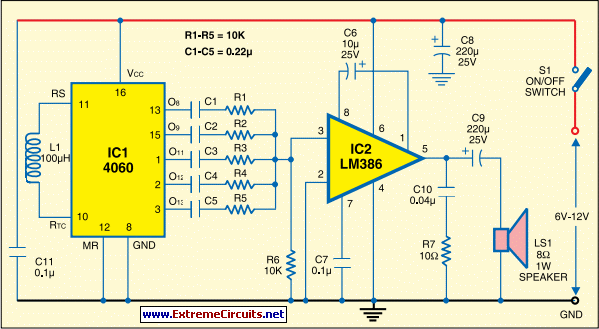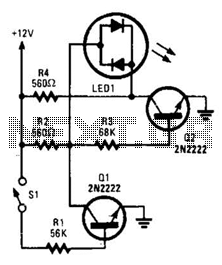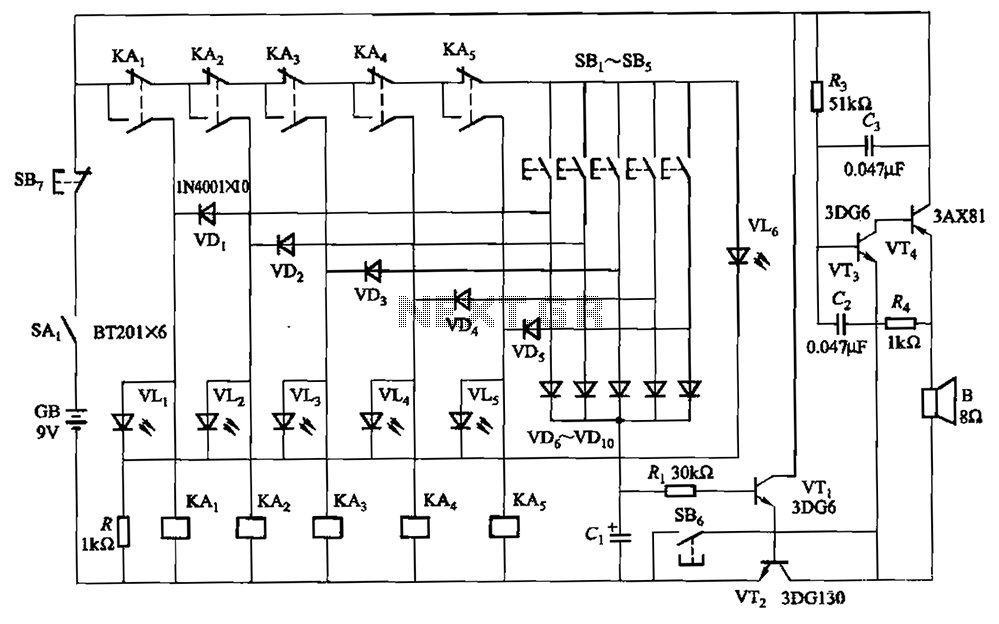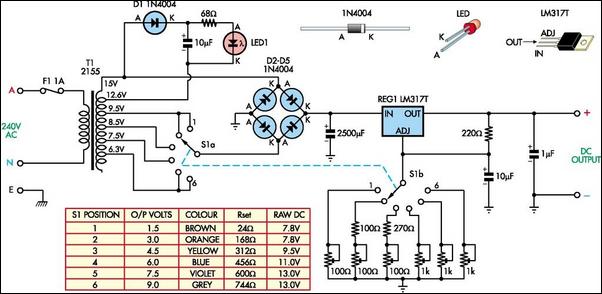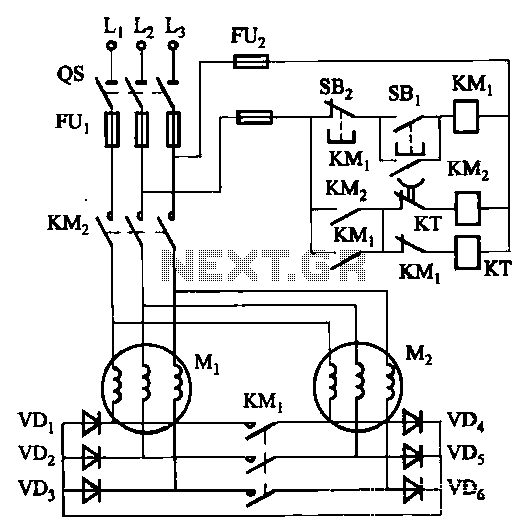
Delay circuit diagram of energy-saving lamps
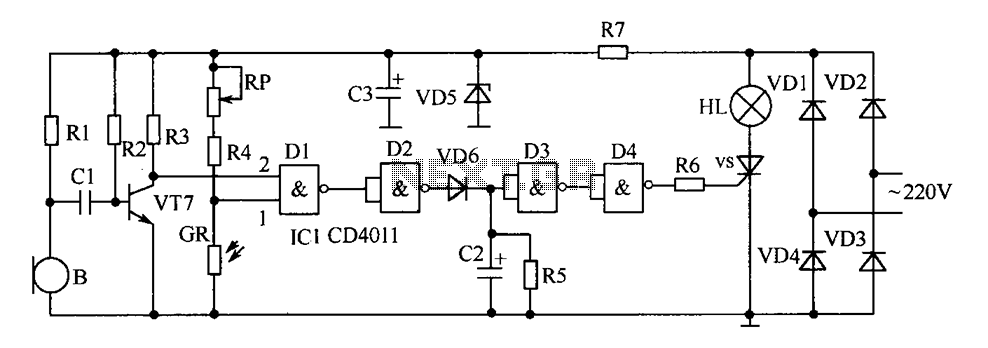
The delay-saving lamp circuit functions as a sound and light control delay energy-saving lighting system. It can directly replace a standard light switch without modifying the existing lighting circuits. In bright or daytime conditions, the sound control feature ensures that the bulb remains off, while at night or in low-light situations (such as voices or footsteps), the lights will automatically turn on. After approximately 30 seconds (this time is adjustable), the lights will turn off automatically. This system is particularly suitable for staircases, corridors, and other areas where brief lighting is required. The circuit includes a diode bridge (VD1 to VD4) that rectifies AC power into pulsating DC. This is then regulated and filtered to provide 8V DC to the CD4011 NAND gate and the power transistor (VT7). Component selection includes four 2-input NAND gates (CD4011), a unidirectional thyristor (MCR100-8), silicon rectifier diodes (1N4007 for VD1-VD4), a zener diode (2CW56 for VD5), silicon switching diodes (1N4148 for VD6), and an NPN transistor (9013 for VT7). The circuit also features a photosensitive resistor (MG45), carbon film resistors with specified values, and various capacitors (C1, C2, C3) with designated capacitances. An electret condenser microphone (CRZ2-113F) is used for sound detection.
The delay-saving lamp circuit is designed to enhance energy efficiency and convenience in lighting applications. The core functionality involves the integration of sound detection to control the lighting based on ambient conditions. The circuit operates by utilizing a diode bridge rectifier (VD1 to VD4) that converts the AC supply voltage into a pulsating DC voltage. The subsequent regulation by the zener diode (VD5) ensures a stable 8V output, which is essential for powering the NAND gate (CD4011) and the transistor (VT7).
The NAND gates, configured in a suitable logic arrangement, process the input signals from the microphone and the photosensitive resistor. The microphone (B) picks up sound signals, which are amplified and processed to trigger the lighting system. The photosensitive resistor (GR) detects ambient light levels, preventing the lights from activating during the day or in bright environments.
The adjustable timing circuit, facilitated by the capacitor (C3) and associated resistors, allows for a customizable delay before the light turns off, catering to various user preferences. The resistors (R1 to R7) are strategically chosen to set the appropriate thresholds for sound detection and timing. The use of potentiometers (RP) enables fine-tuning of the sensitivity and delay settings.
In terms of component selection, the circuit uses reliable and readily available electronic components. The silicon diodes (1N4007 and 1N4148) are chosen for their robustness and efficiency in rectification and switching applications. The thyristor (MCR100-8) is selected for its capability to handle the load and provide control over the light output. The NPN transistor (9013) is utilized for its amplification properties, ensuring effective control of the load based on the logic outputs from the NAND gates.
Overall, this delay-saving lamp circuit is an effective solution for energy-efficient lighting control, providing automated lighting in response to sound and light conditions, thus enhancing safety and convenience in various environments.Delay saving lamps as shown is a sound and light control delay energy-saving lighting double. It can directly replace ordinary light switch without changing the original lighti ng circuits, day or strong light situations even greater sound can also control the bulb does not light, sound encountered at night or low light (such as voices, footsteps sound, etc.) after the lights turn on automatically, after about 30s (time can be set) automatically turn off. Suitable for staircases, corridors and other places lighting just short. Diode VD1 ~ VD4 bridge rectifier circuit composed of the city into a pulsating DC power, and then by limiting R7, VD5 regulator, C3 filtered output 8V DC, for the manifold CD4011 and provide power transistor VT7.
Component selection: NAND gate D1 ~ D4 is available a 2-input NAND gate CD4011 four digital integrated circuits. VS is MCR100-8 type and other small plastic unidirectional thyristors. Rectifier diode VD1 - VD4 available 1N4007 type silicon rectifier diode ordinary, VD5 election 2CW56 type 8V zener diode, VD6 common type available 1N4148 silicon switching diodes, VT7 available 9013 type and other silicon NPN transistor.
GR is MG45 photosensitive resistor, the remaining resistors are used RTX-1/8W carbon film resistors, wherein R1 is 22k, R2 is 22M, R3 is 33k, R4 is 47k, R5 is 1.5M, R6 is 5.10, R7 is 240k, RP take W106-2-2 type 100k glass glaze preset potentiometers. C1 with CT1 type ceramic capacitors, C2, C3 electrolytic capacitors C1 and take 0.1 F, C2 take 22 F/16V, C3 take 100 F/16V.
B is CRZ2-113F type electret condenser microphone.
The delay-saving lamp circuit is designed to enhance energy efficiency and convenience in lighting applications. The core functionality involves the integration of sound detection to control the lighting based on ambient conditions. The circuit operates by utilizing a diode bridge rectifier (VD1 to VD4) that converts the AC supply voltage into a pulsating DC voltage. The subsequent regulation by the zener diode (VD5) ensures a stable 8V output, which is essential for powering the NAND gate (CD4011) and the transistor (VT7).
The NAND gates, configured in a suitable logic arrangement, process the input signals from the microphone and the photosensitive resistor. The microphone (B) picks up sound signals, which are amplified and processed to trigger the lighting system. The photosensitive resistor (GR) detects ambient light levels, preventing the lights from activating during the day or in bright environments.
The adjustable timing circuit, facilitated by the capacitor (C3) and associated resistors, allows for a customizable delay before the light turns off, catering to various user preferences. The resistors (R1 to R7) are strategically chosen to set the appropriate thresholds for sound detection and timing. The use of potentiometers (RP) enables fine-tuning of the sensitivity and delay settings.
In terms of component selection, the circuit uses reliable and readily available electronic components. The silicon diodes (1N4007 and 1N4148) are chosen for their robustness and efficiency in rectification and switching applications. The thyristor (MCR100-8) is selected for its capability to handle the load and provide control over the light output. The NPN transistor (9013) is utilized for its amplification properties, ensuring effective control of the load based on the logic outputs from the NAND gates.
Overall, this delay-saving lamp circuit is an effective solution for energy-efficient lighting control, providing automated lighting in response to sound and light conditions, thus enhancing safety and convenience in various environments.Delay saving lamps as shown is a sound and light control delay energy-saving lighting double. It can directly replace ordinary light switch without changing the original lighti ng circuits, day or strong light situations even greater sound can also control the bulb does not light, sound encountered at night or low light (such as voices, footsteps sound, etc.) after the lights turn on automatically, after about 30s (time can be set) automatically turn off. Suitable for staircases, corridors and other places lighting just short. Diode VD1 ~ VD4 bridge rectifier circuit composed of the city into a pulsating DC power, and then by limiting R7, VD5 regulator, C3 filtered output 8V DC, for the manifold CD4011 and provide power transistor VT7.
Component selection: NAND gate D1 ~ D4 is available a 2-input NAND gate CD4011 four digital integrated circuits. VS is MCR100-8 type and other small plastic unidirectional thyristors. Rectifier diode VD1 - VD4 available 1N4007 type silicon rectifier diode ordinary, VD5 election 2CW56 type 8V zener diode, VD6 common type available 1N4148 silicon switching diodes, VT7 available 9013 type and other silicon NPN transistor.
GR is MG45 photosensitive resistor, the remaining resistors are used RTX-1/8W carbon film resistors, wherein R1 is 22k, R2 is 22M, R3 is 33k, R4 is 47k, R5 is 1.5M, R6 is 5.10, R7 is 240k, RP take W106-2-2 type 100k glass glaze preset potentiometers. C1 with CT1 type ceramic capacitors, C2, C3 electrolytic capacitors C1 and take 0.1 F, C2 take 22 F/16V, C3 take 100 F/16V.
B is CRZ2-113F type electret condenser microphone.
